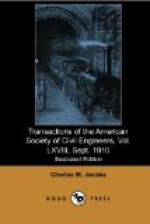The work just described as the 32d and 33d Street lines, terminating at the easterly end at the First Avenue shafts, was placed under contract on May 29th, 1905, with the United Engineering and Contracting Company. The plans then provided for three-track tunnels from the west end of the work under the contract eastward 1,628 ft. in 32d Street and 1,418 ft. in 33d Street to the west line of Fifth Avenue, with a descending grade of 0.4%; this was to constitute, in a degree, an extension of the station, where trains could stand without brakes while awaiting signals to proceed to or from the station. From Fifth Avenue eastward to the lowest point under the river, the grade was to be 1.5% on all lines. Later, during construction, when excavating westward under 33d Street from Fifth Avenue, the surface of the rock was broken through, disclosing quicksand; within the next few days trial drill holes through the tunnel roof at 32d Street and Fifth Avenue showed a thin cover with quicksand above it. The conditions had been indicated in a general way by borings made before construction was begun, but they proved to be rather worse than anticipated. On the topographical map of Manhattan Island, made by General Egbert L. Viele in 1865, is shown a watercourse which had its source near what is now Broadway and 44th Street, flowing thence along the west side and south end of Murray Hill, passing under the present site of the Waldorf-Astoria Hotel, crossing 33d Street at the point where the rock surface was broken through in the tunnel excavation, as above stated, crossing 32d Street at its intersection with Fifth Avenue, where trial drilling showed thin rock cover over the tunnel excavation, passing thence eastward a short distance south of 32d Street, which it recrossed near Third Avenue, and finally discharging into the East River near 34th Street, and a little west of the present First Avenue. The ancient creek apparently followed the course of a valley in the rock, the valley having become filled to a considerable depth with very fine quicksand. This concurrence of depressions in the rock surface with the watercourse shown on Viele’s map was noted in so many places and the difficulties of construction were so serious at these places, that a section of the map showing the old topography along and adjacent to the station and tunnel lines is reproduced in Plate IX.
[Illustration: Plate XI.—Long Island Shaft. Lines A and B]
The unfavorable conditions developed at Fifth Avenue affected both the construction of the tunnels and the maintenance of adjacent buildings. It would be necessary to construct the tunnels in open cut for a large part of the way westward, causing serious inconvenience to the public; the buildings were mostly of the older class, founded in earth, but there were several modern high buildings with foundations in the same material; some of these had been built since the tunnels were planned. In view of these added




